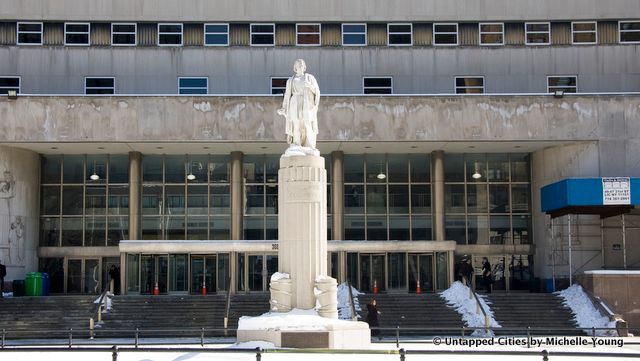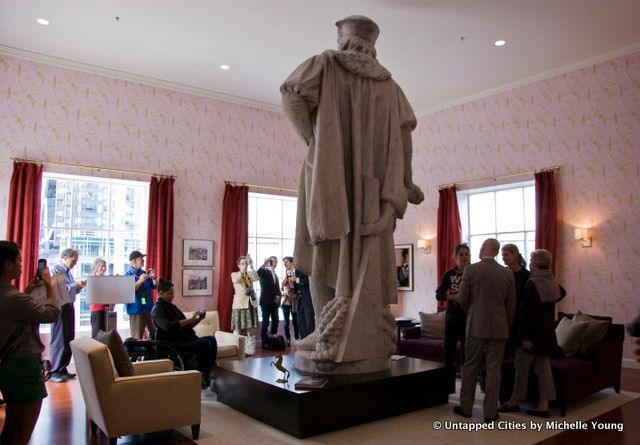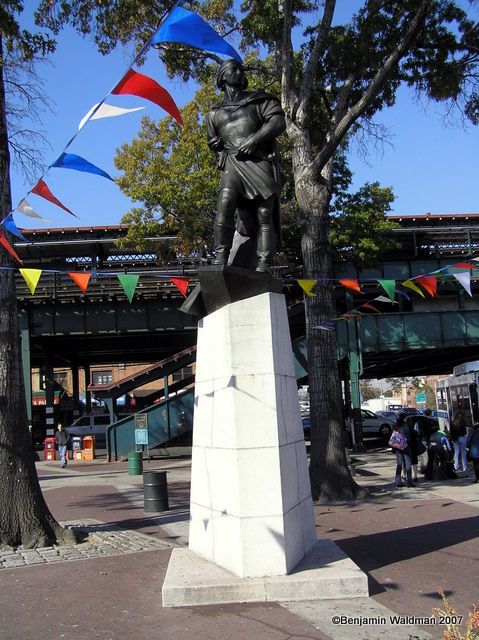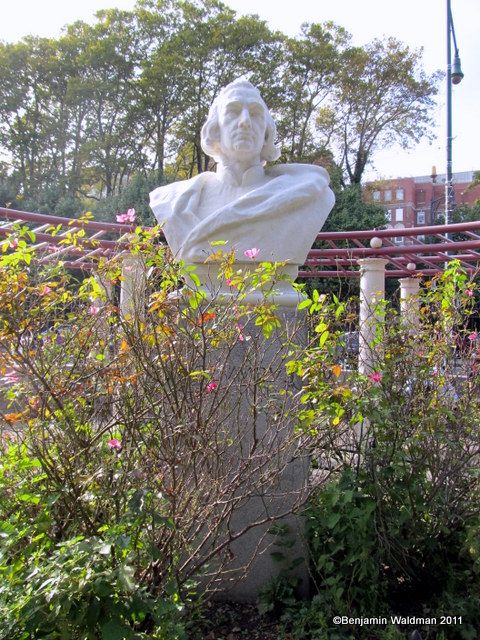Last-Minute NYC Holiday Gift Guide 🎁
We’ve created a holiday gift guide with presents for the intrepid New Yorker that should arrive just in time—




Though opinions on Christopher Columbus have drastically changed in recent years (Seattle recently swapped Columbus Day for Indigenous Peoples’ Day), Columbus has long been at the center of our national consciousness and New York City’s in particular. Columbia College was christened in 1784, Manhattan’s Ninth Avenue was renamed Columbus Avenue in 1890 and Columbus Circle was constructed in 1905. There are also five statues of Christopher Columbus across four boroughs (for a time, three of the five were in Manhattan), only George Washington has more. Presented below from most famous to most obscure are New York City’s Columbus monuments.

Discovering Columbus installation by Tatzu Nishi in 2012
The monument dedicated to Columbus at Columbus Circle was unveiled on October 12, 1892. It commemorated the 400th anniversary of his arrival in the New World. Close to ten thousand people attended the dedication ceremony where General L.P. di Cesnola, the Director of the Metropolitan Museum of Art, spoke about how Columbus’ “true monument is this great land, its institutions, its prosperity, its blessing, its lessons of advance for all humanity.”
The statue of Columbus and the column it rests upon are carved of Carrara marble, with additional ornamentation depicting Columbus’ journey, American patriotic symbols, and allegorical figures. The monument was restored in 1992 in commemoration of the 500th anniversary of Columbus’ expedition, and in 2012 artist Tatzu Nishi encircled the statue with a living room, enabling visitors to get up close with the statue.
Also discover our Vintage Photos of Columbus Circle.

In Brooklyn’s Columbus Park, just next to Brooklyn Borough Hall is a Christopher Columbus statue by Emma Stebbins, a female artist relatively unknown today but was one of the foremost nineteenth-century American women sculptors. Though her most famous work is the Angel of the Waters statue on Bethesda Fountain in Central Park, Stebbins also sculpted Brooklyn’s statue of Columbus. The statue was commissioned around 1863 by Marshall O. Roberts, a merchant and art patron, and was Stebbin’s only life-sized work in marble.
According to Roberts, “Columbus is represented as standing upon the deck of a ship alone and at midnight, just before the land of the Western continent burst upon his view. His mutinous crew have all deserted him and are feasting below, while he-the intrepid discoverer with a firm grasp upon the rudder post, looks eagerly, anxiously forward, piercing the darkness with his eye of faith and with earnest prayers to heaven for success, waits for the dawning of the day which, coming at last, brings with it victory and repose.”
The statue was gifted to the City in 1869 and was supposed to be placed in Central Park under a protective glass housing. It was possibly erected Central Park for a time but was then removed and forgotten. In 1934, the statue was discovered in the 97th Street maintenance yard in Central Park. It was then erected in Columbus Park in Chinatown, where it remained until 1971 when it was reinstalled in Brooklyn’s Columbus Park.

On Saturday May 12th 1894, the Central Park statue of Christopher Columbus was dedicated. According to the dedication program, “no more beautiful day…could have been selected for the unveiling of Jeronimo Sunol’s bronze statue.”It is situated directly opposite John Quincy Adams Ward’s monument of Shakespeare on the Mall. The statues were said to be appropriate companions as they are “two great heirs of fame of the fifteenth and sixteenth centuries.” Dignitaries included the Vice-President, ambassadors, and even Julia Ward Howe who wrote a poem for the occasion. The statue contains “religious and imperialist imagery.” Next to Columbus is a globe mounted to a cable entwined capstan and he holds the Spanish flag with a cross on top in his right hand. His left arm is outstretched and eyes “looking upward to heaven in gratitude for his successful voyage.” Sunol based the statue on a previous one he designed in 1885 for the Plaza de Colon in Madrid.

Columbus Square was renamed for Columbus on April 1, 1930, by the Board of Aldermen. In 1937, the Italian Chamber of Commerce installed a bronze tablet on the site with the intention of erecting a life-sized statue of Columbus. The WPA commissioned Angelo Racioppi to create the statue, which was unveiled in 1941. Over 5,000 people were in attendance, including Mayor LaGuarida, however this dedication was short lived. Funding had not materialized for the statue’s base and those behind the statue feared that the statue would be recycled for weapons during World War II, so they hid it in the basement of Queens Borough Hall. (The residents were possibly not paranoid as the New York Life Insurance Building’s statue of Atlas might have met the same fate). By 1943, the statue was placed on its granite based and the plaque was retained as a memento. Today, the Annual Queens County Columbus Parade terminates at the Borough’s sole Columbus statue.

The Piccirilli Brothers are most famous for carving Daniel Chester French’s Abraham Lincoln statue in the Washington D.C.’s Lincoln Memorial. The Brothers are intimately connected with New York City and many of their works can be found here including sculptures at the Alexander Hamilton Customs House, the New York Stock Exchange, the New York Public Library, the Washington Square Arch, and the Brooklyn Museum. The
Piccirilli Brothers lived and worked in the Bronx on 142nd Street (though their studio was demolished in the 1970s). Their Christopher Columbus statue is one of the only works by the Brothers in the Bronx, located just off of Arthur Avenue in D’Auria-Murphy Triangle. Moved herein 1992, it had previously been located at P.S. 45 on Bathgate Avenue and East 189th Street.

The 59th Street Subway Station aptly has terra cotta tiles that relate to the eponym of the roundabout under which the subway station is located, Christopher Columbus. The tiles depict ships, which are usually described as being Columbus’ caravel (a highly maneuverable 15th century sailing ship), the Santa Maria. However, some of the more nautically inclined individuals argue that it is either a different ship, or attention was not paid to detail. When the station was restored a few years ago, some early prototype tiles were discovered, which the MTA pledged to exhibit (though they still appear to be hidden).
Next, see vintage photographs of Columbus Circle over the years.
Subscribe to our newsletter